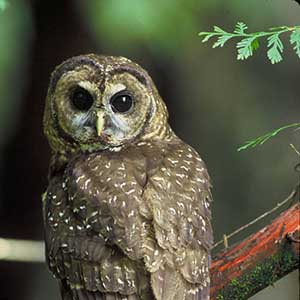
A new partnership between an independent power producer and the B.C. government promises to pour more money into the recovery of the spotted owl, the province's most endangered bird -- while chipping away a little bit more of its habitat.
Innergex Renewable Energy has made a contribution of $287,790 to the Ministry of Forests, Lands and Natural Resource Operations' spotted owl recovery program.
According to a government press release, the money will be used for "activities including inventory and monitoring work, supporting the captive breeding program, and other activities to recover spotted owls."
In exchange, Innergex will move ahead with its Tretheway Creek run-of-river hydroelectric project. The facility is under construction north of Chilliwack, near the north end of Harrison Lake.
The project and an associated transmission line will pass through a wildlife area protected as habitat for the recovery of the endangered owl.
Innergex has promised to make a second, similar contribution once the project is complete.
"This funding agreement with Innergex is a big boost to the province's spotted owl recovery efforts," wrote Minister of Forests Steve Thomson in the release. "This is an example of our government working collaboratively with industry to promote sustainable resource development, while also providing critical support to endangered species."
'Money doesn't help'
But Mark Boyce, an ecologist at the University of Alberta who has done extensive research on spotted owls, said the agreement is "outrageous."
"Basically, it's a façade to avoid doing the right thing," he said. "It's a very serious mistake."
Boyce explained that 85 per cent of bird species that go extinct do so because of habitat loss. And it's habitat loss that has reduced British Columbia's one-time population of roughly 1,000 adult spotted owls to just 16 known animals living in the wild.
Logging has decimated much of the old-growth forest that the owls need to survive. Spotted owls hunt in the open spaces beneath the canopies of old trees, feeding on flying squirrels and other rodents. They can't thrive in younger forests because there are too many trees packed closely together.
It can take 125 years for old-growth forest to grow back once it's been cut.
Boyce said that putting money into a captive breeding program while damaging more of the birds' habitat is hardly a fair trade.
"If you destroy the habitat, there's no place to put the animals from a captive breeding program," he said.
He also said that only one out of 17 captive breeding programs is successful at reintroducing a healthy population to the wild, calling the whole concept of captive breeding "a conservation failure."
There are currently 17 owls in B.C.'s captive breeding program, but there have not yet been any animals reintroduced to their natural habitat.
Innergex's development won't disturb a very large area -- just 54 out of the 325,000 hectares of Crown land that have been designated as spotted owl habitat. The Tretheway Creek protected habitat isn't currently home to any owls, either; it's been set aside as an area for the birds to move into if the population grows.
But Dick Cannings, a biologist and birder from the Okanagan Valley, said building a transmission line will "permanently damage the spotted owl habitat," because the trees won't be allowed to grow back, the way they would after logging.
He added that the 325,000 hectares of owl habitat is a misleading figure, as some of that area has already been logged.
Gwen Barlee, policy director of the Wilderness Committee, said that every little bit of land counts when it comes to the spotted owl. She said the development will further carve up the owls' already fragmented habitat.
"Money doesn't help the spotted owl," she said. "What they need is habitat."
Innergex contests impact
Barlee believes this is further evidence that independent power producers are not doing enough when it comes to environmental protection.
There are currently 86 IPPs selling electricity to BC Hydro. That number has grown since 2002, when the newly-elected Liberal government announced that BC Hydro would no longer build its own facilities to produce electricity.
In 2013, the Wilderness Committee released an internal report from the Ministry of Forests, Lands and Natural Resource Operations that revealed 700 instances of non-compliance at 16 IPPs operating in the South Coast region in 2010.
Many of the non-compliance issues were related to river water levels being changed so quickly that fish may have been stranded and killed.
One of the IPPs shown to have caused repeated fish kills was the Ashlu Creek run-of-river project near Squamish, a project fully owned by Innergex.
In an emailed statement to The Tyee, however, an Innergex spokesperson wrote that the company has "limited impact on the environment. Most non-compliance issues are administrative in nature with no material impact on the environment."
A second report, obtained by the Vancouver Sun that same year, found that many IPPs were not fulfilling all of their environmental monitoring commitments. Many failed to provide assessments of species at risk like the spotted owl.
Too late for the spotted owl?
Barlee said the provincial government is failing to protect endangered species like the spotted owl, pointing out that British Columbia and Alberta are the only two Canadian provinces with no stand-alone endangered species legislation.
But at this point, it's difficult to say whether any legislation can save B.C.'s spotted owls. And throwing more money at the problem may not improve the situation, either.
Millions have been spent on the spotted owl recovery program since 1985, yet the wild population numbers less than 20. Cannings said that most of the wild owls are not breeding, either because they are too old or they lack a partner. He said only one or two nests are attempted each year.
Meanwhile, logging and hydro projects in owl habitat continue to be approved. In that context, Innergex's contribution could be another drop in a bottomless bucket.
Scott Findlay, a conservation biologist at the University of Ottawa, said government needs to make difficult decisions about where to focus conservation efforts, and needs to consider factors like the enormous cost of bringing species back from the edge of extinction.
"I think that we should be making decisions and prioritizing species," he said. "And there should be pragmatic criteria that enter into the prioritization system."
Still, Findlay sees hope for the spotted owl, calling it an "iconic species." He pointed to the California condor, a poster child of conservation efforts. The bird became extinct in the wild in the late 1980s, but has since been successfully reintroduced and the wild population now numbers several hundred.
Like Findlay, Cannings believes the spotted owl can be saved. But he's also cautious.
"I'm not optimistic that it will happen in my lifetime." ![]()
Read more: Environment















Tyee Commenting Guidelines
Comments that violate guidelines risk being deleted, and violations may result in a temporary or permanent user ban. Maintain the spirit of good conversation to stay in the discussion.
*Please note The Tyee is not a forum for spreading misinformation about COVID-19, denying its existence or minimizing its risk to public health.
Do:
Do not: